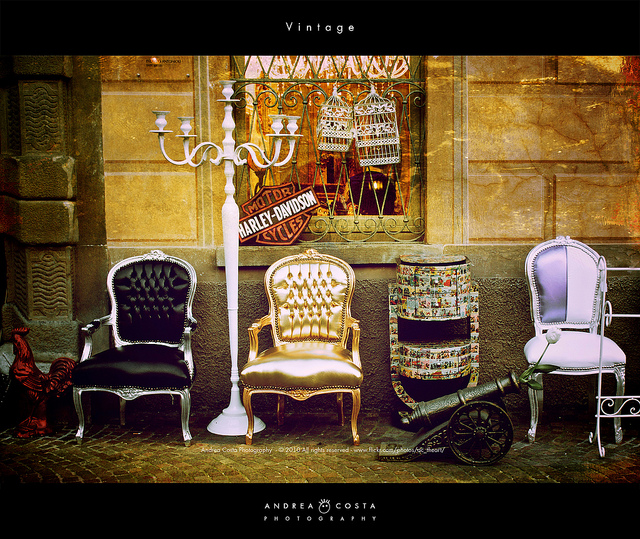This month at Postconsumers, we’re shining the light on some activities, hobbies, niches or even social norms that are ridden with consumerism but are often thought of as being postconsumer alternatives. Today, we’re tackling the fun but loaded topic of vintage shopping. Buying pre-owned items is a great way to create some distance between yourself and the consumer machine, but it’s also an opportunity to fall into an easy marketing niche. We support pre-owned, but we want you to be aware of what consumer traps may be laying out there for you.
Pre-Owned or Vintage Style? Which Is Your Motivation?
Firstly, let’s have a frank discussion. There is a significant difference between wanting to own something that is pre-owned for ethical, financial or even environmental reasons and wanting to own something that is vintage for aesthetic or fashion reasons. If your reason is the latter, then we still applaud you for doing your part to reduce the amount of new “stuff” that goes into circulation daily. However, chances are that you’re still following a traditional hooked consumer path – and that’s ok! There are plenty of resources on this website to help you to find your comfort zone in the realm of informed consumerism. However, if your reasons for wanting to own something pre-owned are for the former reasons, you may want to be aware of the consumer tricks at play even as you shop.
You’re Still Being Encouraged to Craft Your Identity Around Your Stuff
One of the most insidious types of consumer trap is the trap of encouraging you to craft your identity around the possession of a type of “stuff.” Large fashion brands do this particularly well. You are one type of person if you own Levi’s jeans and another type of person altogether if you own Calvin Klein jeans. You are one type of person if you drive a Ford and another type if you drive a foreign car. And these types of identities formed around stuff not only influence what you purchase when you need to buy or replace something, they cause you to think that you need to or feel compelled to buy things that you don’t need just to “complete” your identity or find union with other people with similar identities. The same is true in many cases with the idea of vintage merchandise. It becomes less of a choice of buying for specific reasons and more of a purchasing pattern or aesthetic designed to confirm, promote or declare your identity. You’re that chick or that dude with the cool vintage look. You’re “above” Walmart, but your favorite weekend activity is taking your coffee to the vintage store to look for cool finds. It’s okay to like to dig through the vintage trove for special things, but it’s not okay under any circumstances for your identity to be tied to the accumulation of stuff or a specific type of stuff. And more than many niches, vintage dealers and marketers know this and play to your sense of identity and stuff.
Shopping as an Experience and Lifestyle Choice Versus a Necessity
Much like tying stuff to an identity is dangerous, tying the practice of leisure shopping to a lifestyle is dangerous. We want to be totally clear – we don’t think that it’s a requirement of life or postconsumerism that you hate the process of shopping or that you only shop for absolute necessities when you definitively need them. Shopping can be a fun social outing and you need to find your own comfort zone. But the idea that every weekend should be spent shopping your local vintage circuit because that’s what “your type of people” do is just as much an infiltration of the consumer society into your life as is the idea that weekends should include brunch and a trip to Niemen Marcus just because that’s what “your type of people do.” Shopping is an event, absolutely. But it’s also not an integrated part of a lifestyle choice. However, an important tactic used in vintage marketing is to make you think just that – that there’s innate satisfaction in shopping as part of your life and that you can find joy in the items that you uncover. The joy is neither in the stuff nor in the lifestyle experience. It could be in the social interaction or act of being out in the world, but we’d certainly like to point out that there is almost no way to get the satisfaction of enough by shopping!
Vintage Aesthetic Turned Into Big Business!
We’ve talked previously about how the movement towards green and eco-friendly products grew into big business. The same is true for vintage. Want to buy vintage but can’t find exactly what you need? There are plenty of large companies making clothing and home décor that are vintage-inspired. So when you don’t spot what you need at your local vintage retailer, you can hop on over to Modcloth and buy a modern-day approximation. And this marketing works precisely because of the association between vintage style and your identity.
So where does this all leave us? Yes, absolutely, without a doubt, purchasing vintage is still better than supporting the newly manufactured, big box consumer economy. But you need to be self-aware and reflective of the possibility that your purchasing decisions are starting to define you. After all, being defined by “stuff” is the antithesis of postconsumerism, even if it’s old stuff!
Did we miss a way that vintage shopping still plays into the consumer machine that you want to share with us? If so, just tell us about it on one of the social media channels below.
Facebook | Twitter | Instagram | Tumblr | Pinterest | Google+
Photo Credit: Andrea Costa via Flickr





